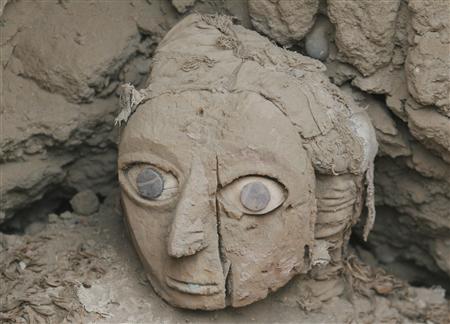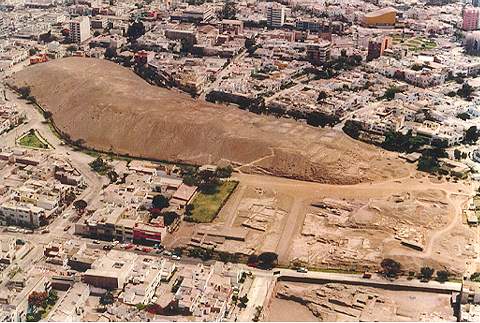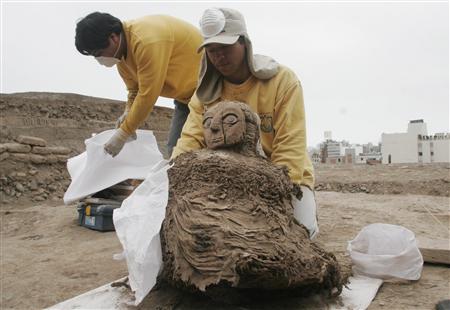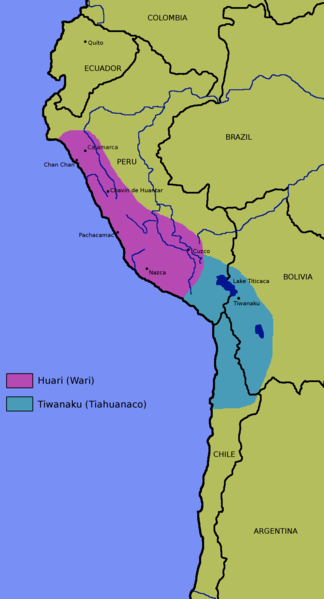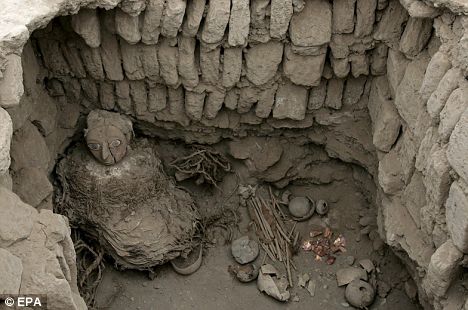Ancient Wari Mummies Discovered in Peru, Alongside Child Sacrifices
posted on September 23rd, 2008 in Archaeology, Peru, Peruvian Mummies, Recent Discoveries
Oh mummy! Archaeologists Unearth Ancient Tribe Members Sacrificed 1,300 Years Ago
The Daily Mail
August 27, 2008
Archaeologists working at an ancient Peruvian burial site have unearthed the first intact ruins belonging to a tribe which existed centuries before the mighty Incas…
Researchers at the Huaca Pucllana ruins in Lima discovered the tomb which is thought to date back to Wari tribal times.
Ancient Huaca Puccllana Ruins Rise up in the Midst of Lima, Peru
It is the first intact Wari burial site discovered in the capital and researchers estimate it is more than 1,300 years old.
Archaeologists also discovered the remains of two other adults and a child.
‘We’d discovered other tombs before,’ said Isabel Flores, director of the ruins.
‘But they always had holes, or were damaged. Never had we found a whole tomb like this one – intact. This enriches Lima’s story.’
Workers wrapped the female mummy in tissue paper before lifting it onto a flat wood board. They exposed her face, revealing two big, bright blue orbs in her eye sockets.
Workers removing the 1,300-year-old “Lady of the Mask” mummy from her tomb in Lima, Peru
‘Her face startled me at first,’ said Miguel Angel, 19, a worker at Huaca Pucllana who helped unearth the tomb.
‘I wasn’t expecting to find anything like that,’ he said.
The Wari people lived and ruled in what is now Peru for some 500 years, between 600 AD and 1100 AD.
Their capital was near modern-day Ayacucho, in the Andes, but they traveled widely and are known for building Peru’s first extensive network of roads.
Ms Flores said about 30 tombs have been found so far at Huaca Pucllana, surrounded by Lima’s busy streets.
When in good condition, Wari tombs can be identified by the ceramic and textile offerings placed around the dead.
Small children were often sacrificed and it is common to find their bodies alongside adult ones.
Archaeologists said the child discovered with the adult mummies at Huaca Pucllana was most likely sacrificed.
The discovery confirms the Wari people buried their dead in what is now Lima and offers a more complete picture of how burials were carried out.
Scientists also discovered the remains of a child as well as an assortment of artefacts.
Archaeologists Unearth 1300-Year-Old Mummy in Peruvian Capital
AFP
Archaeologists have unearthed a well-preserved 1,300-year-old female mummy in a residential area of the Peruvian capital.
The woman was from the Wari culture, said archaeologist Isabel Flores, who heads work at the Huaca Pucllana, a mud-brick complex several blocks large located in the Miraflores district of Lima.
“It is an important find, because we have found over the years several tombs that have been looted, but never one that was intact,” Flores told AFP on Tuesday.
Flores described the find as “a multiple tomb in which three funeral bundles were found. One has an impressive mask with the human characteristics of a woman.”
The multi-layer fabric funeral bundles contain the mummies of the deceased, who were placed in a crouching position with their knees under their chin.
The mask has an aquiline nose, narrow lips, large eyes with white iris and round black pupils. The other mummies are believed to be those of a child and an adult.
The Waris were an influential Andean society that thrived between 700 and 1000. At its height the Wari kingdom encompassed much of the Peruvian Andes and coastal region.
Flores said the Waris commonly attached funeral masks to the mummies of noble women.
“It is a woman because in the surrounding area we found offerings and textile items like those of a (female) weaver,” Flores said. The archaeologists also found ceramics and the remains of children who were offered as sacrifices to accompany the dead person in the afterlife.
Archaeologists made the find, dubbed “The Lady of the Mask,” in the first week of August.
They believe the Huaca Pucllana is one of the most important pre-Columbian ceremonial and administrative centers in Lima.
Peru: Three Pre-Inca Mummies Found in Lima Examined by X-rays
Sept 4, 2008
ANDINA
The three 1,300-year-old mummies recently found in Huaca Pucllana ruins (Lima) were examined by X-rays yesterday to take a look inside these funeral bundles before opening and studying them.
Head archaeologist Isabel Flores said X-rays would help determine the position of the human remains without cutting the mummies open.
“The interesting thing about these mummies is that they are the first to be found intact in this archaeological site. The study of these mummies will help us learn more about the burial techniques of the Wari culture,” Flores added.
She mentioned that in the same place where these three mummies were unearthed, archaeologists noticed the presence of four more.
It was reported that in the coming months more information would be provided about them.
In addition, Peruvian archaeologist Isabel Flores noted that one of the primary goals was to have an on-site museum where these mummies and artifacts could be displayed.
In that regard, the mayor of Miraflores, Manuel Masias, has pledged to do build one in the medium term.
On Tuesday, August 26, a team of Peruvian archaeologists excavating a pyramid at the Huaca Pucllana site found three 1,300-year old mummies from the Wari culture, including a woman with a mask with striking blue eyes.
Huaca Pucllana is a Pre-Incan temple complex which was used by both the Wari and Lima cultures. It is situated in the midst of the modern Limean district of Miraflores, with an area of five hectares.
The Wari culture flourished in Peru’s southern highlands from about 500 to 1000, with the empire stretching from Moquegua in the south to Trujillo in the north.

